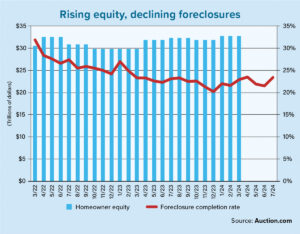New evidence suggests that millennials may be cooling on urban living. In 2018, for the fourth year in a row, millennials and younger members of Generation X (ages 25 to 39 that year) moved out of cities with at least 500,000 residents more frequently than they moved in, according to a Wall Street Journal analysis of U.S. Census Bureau data.
That trend appears to be an opportunity for mortgage originators. Once younger Americans start leaving apartment life in the downtown areas of cities, they’ll surely buy homes in the suburbs or rural parts of the country.
Millennials, in fact, are buying homes in large numbers. They are the largest bloc of homebuyers in the U.S. at the moment. But many others are going from renting apartments to renting single-family homes, says David Howard, executive director of the National Rental Home Council (NRHC).
“Clearly, the millennial generation is going to have an enormous impact on the homeownership market for years to come,” Howard says. “What’s interesting is, we are seeing a number of millennials taking up a first step, if you will, toward homeownership by renting single-family homes.”
We are seeing a number of millennials taking up a first step, if you will, toward homeownership by renting single-family homes.
More Americans are renting today than at any point in the past 55 years, according to the Pew Research Center. The share of renters grew from 31.2% in 2006 to 36.6% in 2016, close to the rentership rate of 37% in 1965.
And the single-family rental market is thriving. The number of occupied, detached rental homes or townhomes rose to a peak of 15.2 million in December 2016, according to American Community Survey data. That number declined to 14.7 million in December 2018, but that’s still a 30% increase from prerecession levels when 11.3 million of these homes were rented.
Howard speculates that many millennials are saving for downpayments. The median downpayment for a single-family home or condominium was $20,250 in third-quarter 2018, according to Attom Data Solutions. Meanwhile, the median asking rent was roughly $1,000 a month at the end of 2019, according to census data.
In some cases, millennials rent single-family homes because they’re “test-driving” neighborhoods in an attempt to figure out where they want to live, Howard says. Others rent single-family homes because they may be living in a certain market for only a short period of time, he says.
Laurie Goodman also says that more people are renting now than in years past and that many of these people are choosing to rent single-family homes. Goodman, co-director of the Urban Institute’s Housing Finance Policy Center, doesn’t believe this is necessarily a generational trend, however. She thinks it was largely due to the state of the housing market immediately after the recession.
“A lot of the homes that were on the market in the aftermath of the financial crisis needed huge amounts of repairs and credit was very, very tight,” Goodman says. “Between the large repair bills, which, by the way, new homebuyers can’t finance easily, and the fact that credit was extraordinarily tight, you had a huge growth in the single-family rental market.”
She notes that homeownership rates dropped dramatically after the recession, but rates have stabilized and grown slightly in recent years. This is occurring at the same time that the number of single-family rental homes have declined slightly.
Still, Howard points to a second-quarter 2019 National Association of Home Builders poll that showed only 12% of adults were considering a home purchase in the next 12 months. That was down from 14% a year earlier.”
We know that a number of people are renting because they want to rent in expectation of buying a home down the road,” Howard says. “We know that other people rent without any expectation that they’re going to buy a home.”
The NRHC is mainly comprised of larger investment companies that own as many as 80,000 single-family rentals. There has been criticism of these large-scale investors purchasing single-family homes and turning them into rentals.
Howard notes that NRHC members own less than 2% of the nation’s single-family rental stock. And he says that these companies spent heavily to renovate many blighted homes after the recession.
There’s no denying the fact that there’s a housing crisis in the U.S., Howard says, and many people are renting because supply and demand in the housing market is so out of balance. “Not only are there not enough homes coming online, there aren’t enough starter homes coming online,” he says.
Until the supply issue is resolved, there’s another path for originators interested in expanding their business. “The interesting opportunity for the mortgage market, I think, is providing capital to individuals and even companies who are interested in purchasing homes for rent, given the growth in demand for rental properties across the country,” Howard says. “I actually think, in terms of the mortgage market, that could be a really interesting opportunity for originators to consider and to take a look at.”




